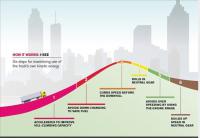New Volvo

The truck industry is searching high and low for solutions that cut fuel consumption. One method is to use the vehicle’s kinetic energy to propel the truck. Now Volvo Trucks has developed I-See, which operates like an autopilot and takes over gearchanging and utilises gradients to save fuel. I-See is linked to the transmission's tilt sensor and obtains information about the topography digitally. The fact that the system is not dependent on maps makes it more dependable since it always obtains the very latest information. I-See can recall about 4000 gradients, corresponding to a distance of 5000 kilometres.
"I-See is an autopilot linked to the truck's cruise control, taking over and handling gearchanges, throttle and brakes on gradients, ensuring they all operate in the most fuel-efficient way possible. I-See freewheels as much as possible - so on certain stretches of road no fuel is used at all," explains Hayder Wokil, product manager at Volvo Trucks. "In this way fuel consumption can be cut by up to 5%. This figure is based on the results of simulations and tests on public roads. I-See requires use of the cruise control, and we know that on average drivers use cruise control about half the time. For a truck in normal operation, covering 140,000 kilometres a year, the saving will be about 1000 litres of fuel annually. This makes a big difference to the haulage firm's profitability," says Hayder Wokil.
I-See carries out six different operations to utilise the kinetic energy to the very maximum. For instance, I-See accelerates up hills, remains in a high gear for as long as possible and freewheels on descents to exploit the truck's weight as a propulsion motor. Other factors that make a difference are air resistance and the truck's weight. All told the system has to keep track of and process a lot of information. Many truck drivers who test I-See will recognise the driving style it adopts. And the last, I-See will become available on the market in 2013.


